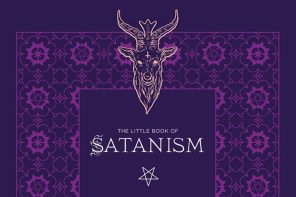The claim that, in her youth, Delaware senate candidate Christine O’Donnell “dabbled into witchcraft” has made headlines for a variety of reasons, not least of which is the strange way O’Donnell herself has chosen to respond to—and therefore highlight—this claim, made offhand in a 1999 episode of Bill Maher’s Politically Incorrect.
O’Donnell’s response has ranged from a campaign television spot that opens with the declaration “I am not a witch” to an appearance on ABC’s Good Morning America where, at the interview’s end, O’Donnell laughingly said she would dress as the Wizard of Oz’s Dorothy this Halloween, saying “kill the witch.”
The would-be senator’s experience in her dabbling days, as she describes it, is of going on a date with some sort of witch; a night that began with a movie and ended with “a little picnic on a satanic altar [where] there was a little blood there and stuff like that.” This absurd “picnic” exemplifies the larger absurdities of the campaign, absurdities made more cringe-worthy because they relate directly to the job she’s running for. In a recent televised debate, for instance, O’Donnell made clear her unfamiliarity with the First Amendment, pressing the point in a series of questions and then quipping: “I’m sorry I didn’t bring my Constitution with me. Fortunately senators don’t have to memorize the Constitution.”
The use of humor as a defensive tactic is something O’Donnell resorts to frequently (as with her repeated and aggressive questions about where, precisely, in the Constitution the separation of church and state is mentioned), but it more often succeeds in deepening a problem than distracting from it. Consider her statement, at a campaign event, that “There’s been no witchcraft since” the picnic, and “if there was, Karl Rove would be a supporter now.” Rove, who has categorized some of O’Donnell’s public comments as “nutty,” might well feel the same about the logic behind this joke.
For those of us interested in religion, the strange midnight picnic becomes a site for untangling confusions about religious practice and religious terms.
What is a Witch?
O’Donnell’s jokey comments draw from the well of popular cultural ideas about witches and witchcraft, conceptions shaped in large part by fiction, theater, movies, and television; from Shakespeare to Frank Baum to J.K. Rowling. Intentional or not, O’Donnell’s invocation of fictional “witchcraft” deflects attention from the fact that her earlier comments, those at the root of this controversy, were about real people and real practices. These tangled categories have tripped up journalists, such that Peter Grier, writing in The Christian Science Monitor, gives in to the lesser angels of his nature and laces an article on the O’Donnell campaign with comments like:
“If she was an actual witch, we would not be having this discussion. The Ministry of Magic would have arrived during the night and wiped any memory of an O’Donnell-witchcraft connection out of our poor Muggle heads.”
There might be humor in this prose, but there is also a condescending dismissal of real religious practices as so much fairytale.
O’Donnell never claimed to have attended a picnic in Oz; she spoke of real-world witchcraft, not fantasy. She spoke of self-identification, of the claim to witch identity—she went on a picnic, in short, with someone who said that he was a witch. The problem is, when it comes to use of the word “witch,” real witches can be nearly as varied as those of novels, movies, and television. Most vocal in their use of the term are segments of the pagan Wiccan communities. Among contemporary Wiccans there is often (following the logic of identity politics) an effort to reclaim the term “witch” as meaning exclusively those of their nature-revering, goddess-rooted traditions. Yet “witch” is a word used for self-identification by contemporary Satanists as well—along with occultists of all stripes.
One rub, with a word like “witch,” as opposed to a word like “Presbyterian,” is that while Wicca and Satanism include many legally-recognized religious organizations, these are also extremely varied religions that, no matter what O’Donnell said on Politically Incorrect, do not require membership in anything like a “coven” in order to be official. In short, one is a witch when one claims to be a witch. One may be a card-carrying member of a coven that is also a legally registered nonprofit, or one may base one’s beliefs and practices on a given text (be it, on the Wiccan side, something like Starhawk’s The Spiral Dance or, to cite one of the more famous contemporary instances of the use of the term within Satanism, Anton LaVey’s classic The Satanic Witch)—or one may not. One can be solitary, self-taught, a bricoleur of the Craft.
It should be emphasized, of course, that Wiccans and Satanists are worlds apart as religious traditions; yet the labeling of “witches” in the Wiccan sense as “satanic” in the Christian sense has a deep history, one that leads Wiccan high priestess Selena Fox, a veteran of the struggle for Wiccan and pagan civil rights, to speak of the O’Donnell mess as a “teaching moment” for Wiccans and all Americans. Not only does this situation present Wiccans with a chance to talk about what “witch” means for those pagans who use the term as a self-description, it also gives us all a chance to consider anew the means by which the religious or cultural other has been and continues to be dehumanized and demonized.
As Fox argues, “The old nature religions of Europe were persecuted for hundreds of years, and part of a tactic for suppressing the pagan practices of old was to label them Satanic or demonic.”
While O’Donnell didn’t say anything about Wicca, per se, her more recent “kill the witch” comments will surely distance her further from pagan communities used to dealing (especially around Halloween) with this confusion between the swirling cultural tropes of “the witch” and those who embrace “witch” as a religious self-description. The Christine O’Donnell dolls released by an action-figure company, featuring the stereotypical cape and pointy hat of a Hollywood witch-villain, merely reinforce this point.
O’Donnell’s Bad Date
Yet if we assume that whoever O’Donnell was “dabbling into witchcraft” with wasn’t any sort of Wiccan, what sort of Satanist might he have been? Diane Vera of “NYC Satanists, Luciferians, Dark Pagans, and LHP Occultists” released a statement to the press honing in on one of the weirder details of O’Donnell’s claims. “As far as I am aware,” said Vera, “no serious practitioner of any variant of either Wicca or Satanism would have a picnic on one’s altar.”
O’Donnell, who has made headlines for various comments on the supposed “cross-breeding” of humans with animals by American scientists, the claim that “condoms will not protect you from AIDS,” and her stance (rooted in her reading of Christian scriptural injunctions not to lust in ones heart) against masturbation, wrote, in a 1997 op-ed in the Washington Post, of proselytizing at a rock concert in her role as then head of the Savior’s Alliance for Lifting the Truth. “Walking through the crowd I also noticed more pentagrams than crosses around the teenage necks,” she wrote, equating the necklaces with Satanism. Diane Vera cites this as an examples of O’Donnell’s “tendency to confuse Satanism with not only Wicca but also rock fan culture.”
We will likely never learn more about that bizarre bloody-altar picnic, and there is surely a danger in focusing on a strange anecdote instead of, as prominent Wiccan theologian Starhawk said recently, “focusing on O’Donnell’s bad date instead of the multiple urgent crises that beset us.”
Yet one perpetual crisis—as old as the American experiment, as old as the notion of a country devoted to the impossible ideals of freedom from the governmental establishment of religion and freedom for citizens’ religious expression—might benefit from continued examination of the various afterlives of this strange date.
Certainly, on the brink of Halloween, with cartoon “witches” popping up all over, the reverberations from O’Donnell’s claims emphasize how difficult it is for those who self-identify religiously as witches to be seen as something other than figures from fiction. While I very much want to take comfort in the possibility of this all being a “teaching moment,” the laughing cry of “kill the witch” tends to drown out that possibility—and point to a long, hard road ahead.




